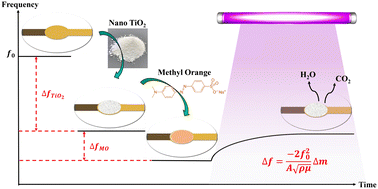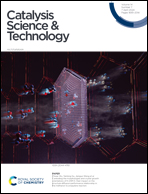Liberation of photogenerated radicals from a nano-titania surface at the solid–air interface†
Abstract
The recent global health crises, exemplified by events such as the COVID-19 pandemic, have propelled self-cleaning photocatalytic nanocoatings into the spotlight. Despite growing interest, the majority of assessments validating the efficacy of these coatings have been predominantly confined to solid–liquid interfaces. In the present study, a TiO2 nano-coating was prepared on a quartz crystal microbalance (QCM) sensor. As a model organic molecule, the potent environment pollutant methyl orange (MO) was dispersed on to these nano-coatings. The sensor was irradiated by ultraviolet (UV) light while monitoring the mass changes at the solid–air interface in situ and in real-time. Morphology and elemental composition of QCM crystal surfaces before and after irradiation were characterized by scanning electron microscopy (SEM), energy dispersive X-ray spectroscopy (EDX), X-ray photoelectron spectroscopy (XPS), and Raman spectroscopy. Liberation of photogenerated radicals upon UV irradiation and a relative humidity (RH) dependent upper limit for the photocatalytic degradation of MO were observed. The diffusion of radicals from solid to air raises the possibility of near vicinity photocatalytic activity. The insights derived from this study can be employed to successfully evaluate the effectiveness of self-cleaning photocatalytic coatings.



 Please wait while we load your content...
Please wait while we load your content...